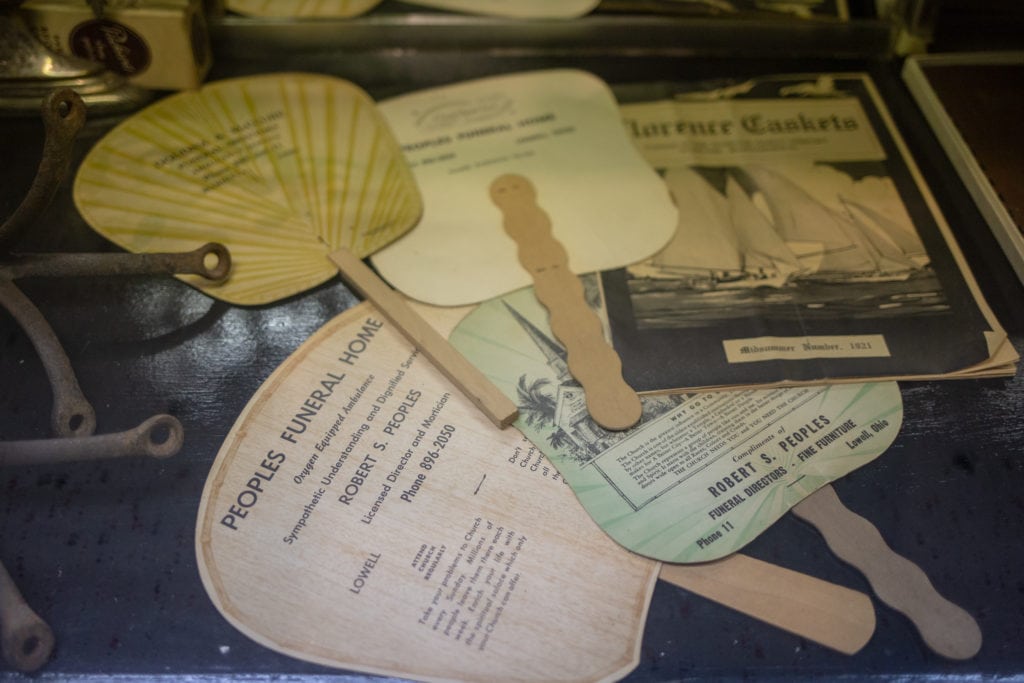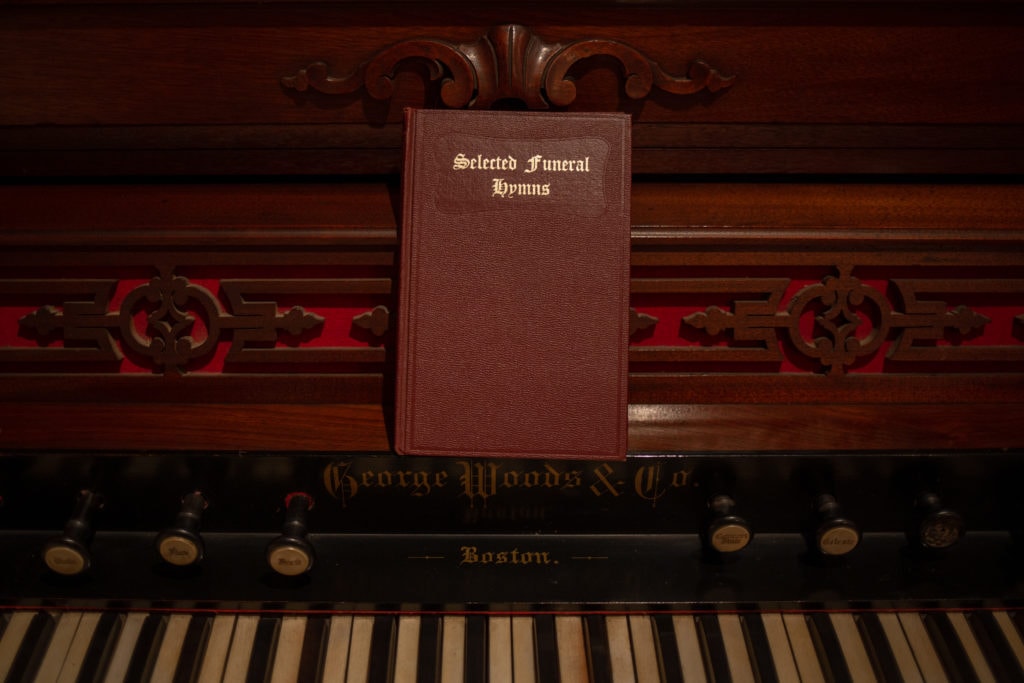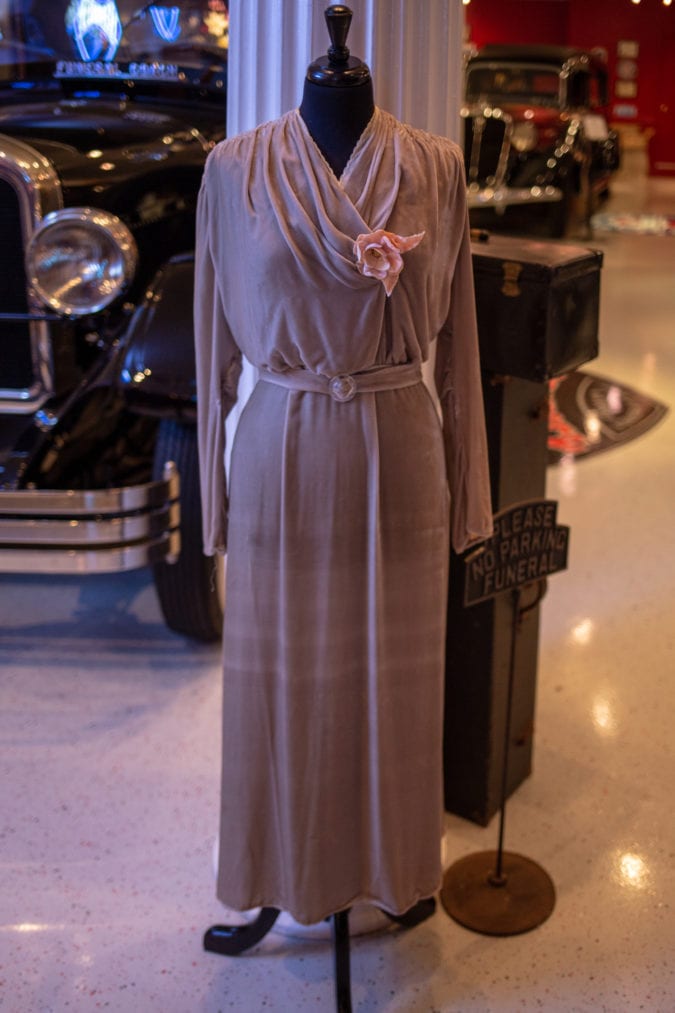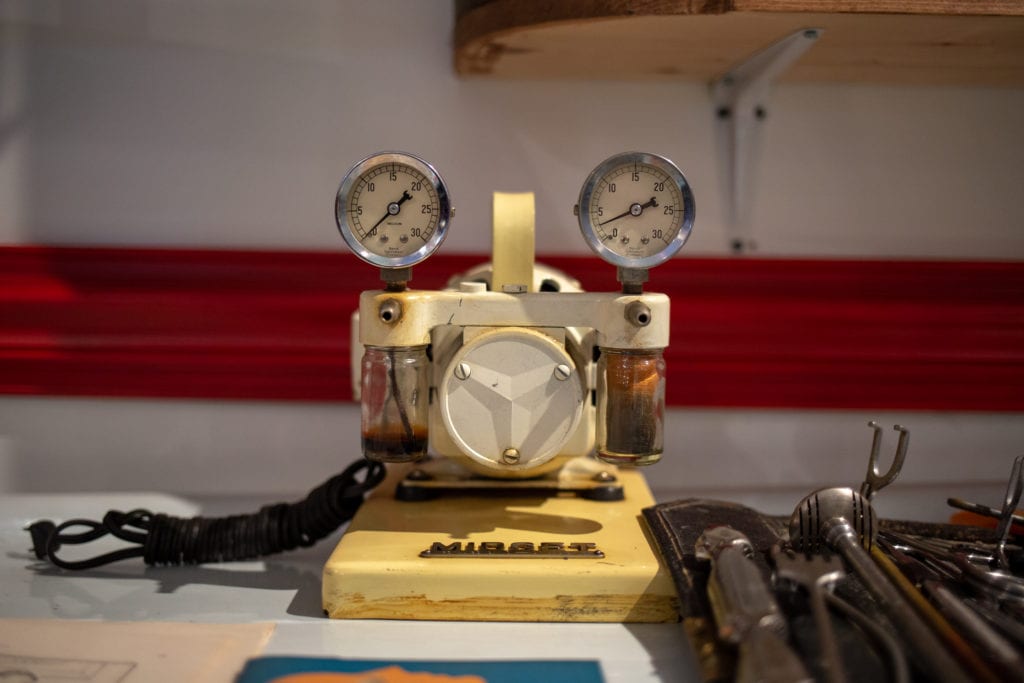In picturesque Marietta, Ohio, just a few blocks from the Ohio River and the Ohio-West Virginia border, two historic Greek-revival houses are connected by a chapel. Small-town funeral homes are often hidden in plain sight—looking more like homes for the living, at least from the outside—and it would be easy to mistake Cawley & Peoples for any of the other tastefully-restored riverfront mansions that line Front Street. Walk just a few hundred feet past the parking lot and you’ll see an equally unassuming garage marked “Mortuary Museum.”
The garage is home to the collection of William “Bill” Peoples, current owner and a funeral director at Cawley & Peoples. He started Peoples Mortuary Museum as a place to store and display his collection of antique cars—in particular, hearses—and the museum has grown over the years to include clothing, caskets, and other grisly tools from the history of the funeral industry.
-

Cawley & Peoples Funeral Home is located in two adjoining historic homes in Marietta, Ohio. | Photo: Alexandra Charitan -

The mortuary museum is located in a garage behind the funeral home. | Photo: Alexandra Charitan
The star of the museum, however, is a fully-restored, 1927 Henney hearse, dubbed “Miss Henney.” The unique car was featured in Woody Allen’s Radio Days, Neil Simon’s Brighton Beach Memoirs, and most recently Get Low, where it starred alongside Bill Murray, Robert Duvall, and Sissy Spacek. Peoples and his wife, Pat, were among the more than 1,000 extras that appeared in the film.
“When you go through the trouble of collecting old cars, or collecting anything for that matter, you learn that part of the pleasure of your hobby is being able to share your collection with others,” Peoples writes in a short story about the Get Low filming experience.
Ice box coffins and paper fans
Peoples was born to work with the dead. He grew up in Marietta, with a father who ran both a funeral home and furniture store—businesses which have more in common than you might think. For people who opt for a traditional burial, a coffin—or its more contemporary sibling, the casket—is the last piece of furniture they’ll ever use.

Cawley & Peoples operates two other locations in Ohio and remains a family business. When I visit the museum, Peoples, who is in his 70s, is not feeling well, so his nephew, Brian Scharff, shows me the collection. Scharff—who casually mentions that the family is somehow related to Don Knotts (The Andy Griffith Show’s Barney Fife)—is a licensed funeral director as well as the home’s advanced funeral planner.
“Bill’s always had a collection of antique cars,” Scharff explains. “He has industry friends that donate things from their funeral homes, but he’s always on eBay actively looking” for new items to add to the museum. An extensive assemblage of mourning jewelry—including intricate hair art and other macabre pieces of memento mori—is a recent addition.
The museum opened in the early 2000s and the collection has already outgrown its current space. Peoples has plans to open up the other half of the building, which is currently used for funeral prep and car storage. Despite its discreet location, Scharff says that the museum frequently hosts groups from all over the country, including the demographic most likely to be found in a funeral home for more traditional reasons—senior citizens.
-

Burial shoes have elastic or lace-up heels to accommodate varying sizes of feet. | Photo: Alexandra Charitan -

Ice box coffins were used to temporarily preserve bodies and safely house people who may have died of communicable diseases. | Photo: Alexandra Charitan -

Paper fans were particularly popular—and useful—at a time when few homes had air conditioning. | Photo: Alexandra Charitan
-

Part of a typical home funeral display. | Photo: Alexandra Charitan -

A collection of mourning jewelry is a new addition to the museum. | Photo: Alexandra Charitan -

Vintage funeral card in a typewriter. | Photo: Alexandra Charitan -

Funeral parking sign. | Photo: Alexandra Charitan -

A Cawley & Peoples plaque inside of a hearse. | Photo: Alexandra Charitan
The museum’s collection includes artifacts from the late 1800s and early 1900s, a time when the majority of funerals were held in private homes. Embalming and viewing tables are on display along with several caskets. Before the advent of embalming, ice box coffins were used to temporarily preserve bodies and safely house people who may have died of communicable diseases. The wooden coffins, lined with copper and insulated with horsehair, include a glass face plate for viewing purposes.
Although the term “basket case” is thought to have originated in the United States shortly after World War I, referring to “a person, especially a soldier, who has lost all four limbs” and therefore has to be carried around in a basket, Scharff claims that the term has origins in the funeral industry. The museum has several wicker baskets on display—precursors to body bags, the baskets were used to transport bodies from the place of death to the funeral home.


Burial clothing was once commonly sold by funeral homes, made of the same fabric used to line the interiors of caskets. Several pairs of shoes—with elastic or lace-up heels to accommodate varying sizes of feet—are also on display.
Just like any other business, funeral homes have to advertise their services. The museum has matchbooks, trade magazines, and branded bottles of smelling salts. Paper fans were particularly popular—and useful—at a time when few homes had air conditioning.
Hearses and Henneys
Peoples owns several classic cars, but the oldest on display is an elaborate horse-drawn hearse. Made by Sayers & Scovill Hearse Builders of Cincinnati, the company—now known simply as S & S Coach—is still making funeral vehicles in Ohio. The black, eight-column, hand-carved hearse was made in 1895 and features beveled glass viewing windows. The kerosene lamps are nickel-plated and the automatic spring roller truck adjusts with the push of a button to accommodate different sizes of caskets.
-

The oldest hearse in the museum’s collection. | Photo: Alexandra Charitan -

This eight-column, hand-carved, horse-drawn hearse was made in 1895 and features beveled glass viewing windows. | Photo: Alexandra Charitan -

1934 Studebaker President hearse. | Photo: Alexandra Charitan -

1940 Henney Packard hearse. | Photo: Alexandra Charitan -

A close-up of the 1927 Henney hearse. | Photo: Alexandra Charitan
The 1940 Henney Packard was based on a passenger car, but designed to function as both an ambulance and a hearse—“a conflict of interest,” Scharff says, laughing. The fully-restored, limousine-style coach still takes the occasional Cawley & Peoples client on their final ride: “We get out this Packard a few times a year when people request an antique car for a funeral,” says Scharff.
When Hollywood needed to stock a 1930s funeral home for Get Low, they first reached out to the National Funeral Museum in Houston, Texas. The museum was able to accommodate the film’s request for caskets, but not a period-appropriate hearse. The Houston museum’s curator reached out to Peoples.


Hearses made after 1938 were too new, and the horse-drawn hearse was too old for the time period depicted in the film. “The 1927 Henney hearse is just right,” Peoples writes. “A funeral home in the mountains of Tennessee during the Great Depression probably would not have been able to afford a new hearse—one that’s six or seven years old would be more accurate for the times.”
Peoples accompanied his beloved car to several filming locations around Georgia. Despite a driving lesson from Peoples, Bill Murray had issues maneuvering the car and damaged its transmission. “Whenever Miss Henney was to be moving, there were actually six men pushing her,” Peoples writes. “At one point, the director had me put on Bill Murray’s coat and hat, so as I steered Miss Henney, it would appear from a distance that he was actually driving.”

Tools of the trade
The museum has reconstructed a typical home-viewing setup, complete with netting traditionally used to keep insects away and obscure any flaws in the body. Today, funeral parlors are built with special lighting to help display the deceased in—quite literally—the best possible light.
Although the setting may look different, the industry as a whole hasn’t changed all that much in the past century. A typical prep room may now be indistinguishable from an operating room, but many of the tools and chemicals remain the same.
Although 35 percent of their clients opt for cremation, Cawley & Peoples pride themselves on their prep work for families that wish to hold a viewing. They don’t use foundation or makeup: “If you do the embalming process right, a lot of the natural color comes back to the body,” Scharff explains. “Like any industry, the more you care, and the more work you put into it, the better the results.”
-

Embalming and prep tools. | Photo: Alexandra Charitan -

Tools of the trade. | Photo: Alexandra Charitan -

Informational brochures and trade magazines. | Photo: Alexandra Charitan -

The embalming process hasn’t changed all that much over the past century. | Photo: Alexandra Charitan -

Embalming machine. | Photo: Alexandra Charitan -

A typical prep room is now nearly indistinguishable from an operating room. | Photo: Alexandra Charitan
Whether you wish to be cremated or buried, Scharff stresses the necessity of making funeral arrangements while you’re still very much alive. “It’s important to get things done ahead of time,” he says. “Advanced arrangements take the burden off of your families shoulders.”
Like his uncle, Scharff grew up around death, but he wasn’t sure if he wanted to follow in his family’s funereal footsteps. “I figured I’d end up in insurance,” he says. He took a job at Cawley & Peoples more than than 20 years ago, assuming it would temporary. “Not long after I started, it grew on me,” he says. “It’s a rewarding job.”
If you go
Peoples Mortuary Museum is located behind Cawley & Peoples at 408 Front Street, in Marietta, Ohio. Please call ahead to be sure there is someone available to take you through the museum, 740-373-1111.







